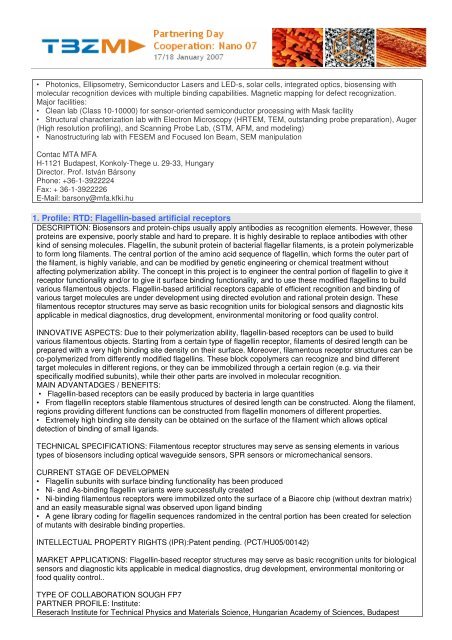17/18 January 2007 Wiener Neustadt - Czelo
17/18 January 2007 Wiener Neustadt - Czelo
17/18 January 2007 Wiener Neustadt - Czelo
Create successful ePaper yourself
Turn your PDF publications into a flip-book with our unique Google optimized e-Paper software.
• Photonics, Ellipsometry, Semiconductor Lasers and LED-s, solar cells, integrated optics, biosensing with<br />
molecular recognition devices with multiple binding capabilities. Magnetic mapping for defect recognization.<br />
Major facilities:<br />
• Clean lab (Class 10-10000) for sensor-oriented semiconductor processing with Mask facility<br />
• Structural characterization lab with Electron Microscopy (HRTEM, TEM, outstanding probe preparation), Auger<br />
(High resolution profiling), and Scanning Probe Lab, (STM, AFM, and modeling)<br />
• Nanostructuring lab with FESEM and Focused Ion Beam, SEM manipulation<br />
Contac MTA MFA<br />
H-1121 Budapest, Konkoly-Thege u. 29-33, Hungary<br />
Director. Prof. István Bársony<br />
Phone: +36-1-3922224<br />
Fax: + 36-1-3922226<br />
E-Mail: barsony@mfa.kfki.hu<br />
1. Profile: RTD: Flagellin-based artificial receptors<br />
DESCRIPTION: Biosensors and protein-chips usually apply antibodies as recognition elements. However, these<br />
proteins are expensive, poorly stable and hard to prepare. It is highly desirable to replace antibodies with other<br />
kind of sensing molecules. Flagellin, the subunit protein of bacterial flagellar filaments, is a protein polymerizable<br />
to form long filaments. The central portion of the amino acid sequence of flagellin, which forms the outer part of<br />
the filament, is highly variable, and can be modified by genetic engineering or chemical treatment without<br />
affecting polymerization ability. The concept in this project is to engineer the central portion of flagellin to give it<br />
receptor functionality and/or to give it surface binding functionality, and to use these modified flagellins to build<br />
various filamentous objects. Flagellin-based artificial receptors capable of efficient recognition and binding of<br />
various target molecules are under development using directed evolution and rational protein design. These<br />
filamentous receptor structures may serve as basic recognition units for biological sensors and diagnostic kits<br />
applicable in medical diagnostics, drug development, environmental monitoring or food quality control.<br />
INNOVATIVE ASPECTS: Due to their polymerization ability, flagellin-based receptors can be used to build<br />
various filamentous objects. Starting from a certain type of flagellin receptor, filaments of desired length can be<br />
prepared with a very high binding site density on their surface. Moreover, filamentous receptor structures can be<br />
co-polymerized from differently modified flagellins. These block copolymers can recognize and bind different<br />
target molecules in different regions, or they can be immobilized through a certain region (e.g. via their<br />
specifically modified subunits), while their other parts are involved in molecular recognition.<br />
MAIN ADVANTADGES / BENEFITS:<br />
• Flagellin-based receptors can be easily produced by bacteria in large quantities<br />
• From flagellin receptors stable filamentous structures of desired length can be constructed. Along the filament,<br />
regions providing different functions can be constructed from flagellin monomers of different properties.<br />
• Extremely high binding site density can be obtained on the surface of the filament which allows optical<br />
detection of binding of small ligands.<br />
TECHNICAL SPECIFICATIONS: Filamentous receptor structures may serve as sensing elements in various<br />
types of biosensors including optical waveguide sensors, SPR sensors or micromechanical sensors.<br />
CURRENT STAGE OF DEVELOPMEN<br />
• Flagellin subunits with surface binding functionality has been produced<br />
• Ni- and As-binding flagellin variants were successfully created<br />
• Ni-binding filamentous receptors were immobilized onto the surface of a Biacore chip (without dextran matrix)<br />
and an easily measurable signal was observed upon ligand binding<br />
• A gene library coding for flagellin sequences randomized in the central portion has been created for selection<br />
of mutants with desirable binding properties.<br />
INTELLECTUAL PROPERTY RIGHTS (IPR):Patent pending. (PCT/HU05/00142)<br />
MARKET APPLICATIONS: Flagellin-based receptor structures may serve as basic recognition units for biological<br />
sensors and diagnostic kits applicable in medical diagnostics, drug development, environmental monitoring or<br />
food quality control..<br />
TYPE OF COLLABORATION SOUGH FP7<br />
PARTNER PROFILE: Institute:<br />
Reserach Institute for Technical Physics and Materials Science, Hungarian Academy of Sciences, Budapest



